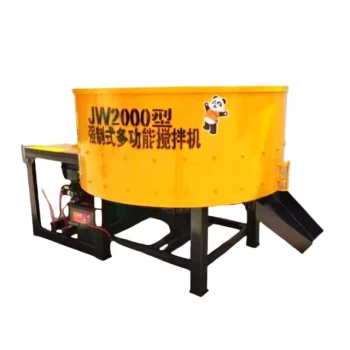A cement mixer is a vital piece of equipment in construction, designed to blend cement, water, and aggregates into a uniform concrete mixture. It operates through a rotating drum equipped with spiral blades that facilitate both mixing and discharging. The process involves loading materials, rotating the drum to achieve homogeneity, and then discharging the mixture. Powered by an electric motor, gasoline engine, or hydraulic system, the mixer ensures consistent quality and prevents premature hardening. Key components include the drum, blades, motor, wheels, and frame, all working together to produce durable concrete for construction projects.
Key Points Explained:
-
Mixing Mechanism:
- The cement mixer uses spiral blades inside the drum to mix materials efficiently.
- One set of blades drags concrete upward and inward during rotation in one direction.
- Another set pushes concrete toward the opening when rotated in the opposite direction, aiding discharge.
- Ever wondered how these blades ensure uniformity? Their spiral arrangement ensures thorough blending and controlled discharge.
- The cement mixer uses spiral blades inside the drum to mix materials efficiently.
-
Operational Process:
- Loading: Cement, water, and aggregates are added to the drum.
- Mixing: The drum rotates, blending materials into a homogeneous mixture.
- Discharging: The mixture is poured out once the desired consistency is achieved.
- Think of it like a giant kitchen blender—just for concrete!
-
Power Source:
- The rotational mechanism is powered by:
- Electric motors (common for stationary mixers).
- Gasoline engines (ideal for remote sites).
- Hydraulic systems (for heavy-duty applications).
- The controlled rotation speed prevents premature hardening, ensuring smooth consistency.
- The rotational mechanism is powered by:
-
Key Components:
- Mixing Drum: The core where materials are blended.
- Blades/Paddles: Integrate materials and facilitate discharge.
- Motor/Engine: Powers the drum’s rotation.
- Wheels & Frame: Provide mobility and structural support.
- These components work like a well-orchestrated team to deliver high-quality concrete.
-
Importance in Construction:
- Ensures a uniform mix, critical for structural strength and durability.
- Saves time and labor compared to manual mixing.
- Did you know? A poorly mixed batch can weaken entire structures—highlighting the mixer’s role in safety.
-
Human Impact:
- Cement mixers empower builders to create everything from sidewalks to skyscrapers.
- They’re the unsung heroes behind the sturdy foundations we rely on daily.
By understanding these points, purchasers can select the right mixer for their projects, balancing power, capacity, and efficiency.
Summary Table:
| Aspect | Key Details |
|---|---|
| Mixing Mechanism | Spiral blades ensure thorough blending and controlled discharge. |
| Operational Process | Loading → Mixing → Discharging (like a giant blender for concrete). |
| Power Source | Electric motors, gasoline engines, or hydraulic systems drive rotation. |
| Key Components | Drum, blades, motor/engine, wheels, and frame work together for optimal mixing. |
| Construction Role | Ensures uniform mix for structural integrity and labor efficiency. |
Upgrade your construction efficiency with Garlway’s durable winches and high-performance cement mixers—contact us today for expert recommendations!
















